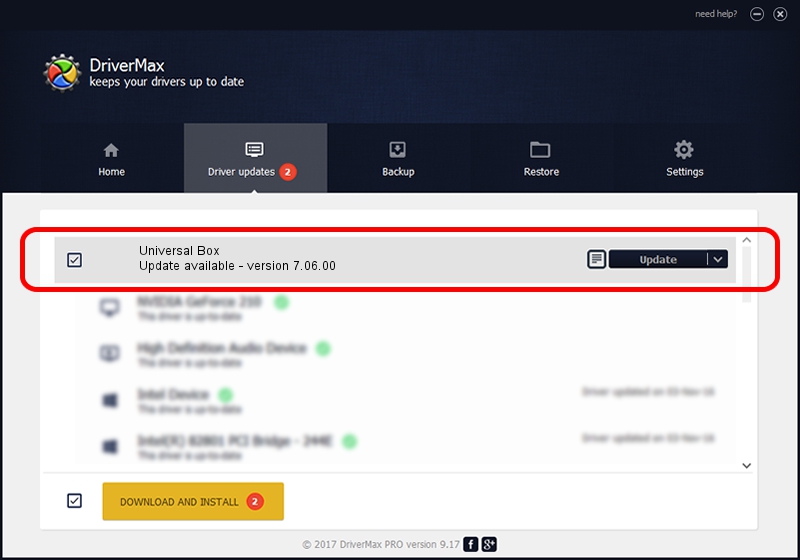Box empowers your teams by making it easy to work with people inside and outside your organization, protect your valuable content, and connect all your apps. Get to know Box Shuttle: The lowest-cost, full-service migration program in the market. Universal Yums is a monthly snack subscription box featuring a different country each month. Try unique snacks and candy from around the world while reading our interactive guidebook! Universal Remote Control for Android TV, TV box, Chromecast, Fire TV, Fire TV Stick, KODI, Smart TV and many more. CetusPlay universal TV remote brings the flawless experience as an alternative to a TV remote with much more unbelievable functionalities.
Wireless Embedded Solutions and RF Components Storage Adapters, Controllers, and ICs Fibre Channel Networking Symantec Cyber Security Mainframe Software Enterprise Software Broadband: CPE-Gateway, Infrastructure, and Set-top Box Embedded and Networking Processors Ethernet Connectivity, Switching, and PHYs PCIe Switches and Bridges Fiber Optic Modules and Components LEDs and Displays Motion.
A variety of sweet and salty snacks are specially brought in from a different country every month.
A 12+ page booklet guides your adventure with trivia, recipes, and other surprises!
Dozens of delightful new flavors to try, like these nutty, sugary, cinnamon-y cookies!
Sign up for a subscription and automatically receive snack boxes each month until you cancel. Or, give as a gift for either 1, 3, 6 or 12 months.
The ship date of your first snack box can be seen during the signup process. Future snack boxes will ship on the 15th of the month, and you'll receive an email with tracking information every time your box ships.
Receive your box of Yums and enjoy the adventure! Feeling full? You can easily cancel your subscription with our one-step cancellation process. Not that you'd want to!

of our customers have recommended
Universal Yums to a friend*
Still have questions?
It depends on where we’re going!
If we’re featuring a chocolate-loving country like Belgium, you’ll find creamy hazelnut truffles and chocolate-covered waffles in your box. However, a box from Thailand might be filled with zesty fried seaweed and salty pineapple candy.
No matter the country, you’ll always find a variety of sweet and savory snacks with unique flavors and spices.
Your first box ship date will be displayed on the Checkout page. After you’ve placed your order, you’ll receive an order-confirmation email with tracking information.
If you live in the United States, your box will be delivered by the US Postal Service or FedEx. For customers outside the United States, your box will be delivered by your government’s postal delivery service.
We offer free shipping within the contiguous United States, as well as military addresses (FPO/APO).
Shipping charges for everywhere else are shown in the table below:
| Country | Yum Box Shipping | Yum Yum Box Shipping | Super Yum Box Shipping |
|---|---|---|---|
| Canada | $4.00 | $6.00 | $13.00 |
| The UK | $3.00 | $6.00 | $13.00 |
| Australia | $6.00 | $12.00 | $22.00 |
| Israel | $6.00 | $12.00 | $23.00 |
| Hawaii | $2.00 | $5.00 | $13.50 |
| Alaska | $2.00 | $5.00 | $13.50 |
| Puerto Rico | $2.00 | $5.00 | $13.50 |
| Guam | $2.00 | $5.00 | $13.50 |
| Virgin Islands | $2.00 | $5.00 | $13.50 |
This topic explains how to set up deployment clients to receive content from a deployment server. In most cases, you just need to specify the deployment server that you want the client to connect to.
Even though this step occurs on the deployment clients, not the deployment server itself, it is an essential part of the overall configuration of the deployment server system.
Important: The deployment server cannot be a deployment client of itself. If it is, the following error will appear in splunkd.log: 'This DC shares a Splunk instance with its DS: unsupported configuration'. This has the potential to lead to situations where the deployment clients lose their ability to contact the deployment server.
Specify the deployment server
On each client, you must specify the deployment server it will connect to. You do this by configuring the client's deploymentclient.conf file. Each deployment client must have a unique network hostname.
There are three ways to configure this file:
- Use the CLI. See 'Use the CLI', later in this topic.
- Edit the file directly. See 'Edit deploymentclient.conf', later in this topic.
- For Windows universal forwarders only: Configure a Windows forwarder as a deployment client during the installation process. See the following Universal Forwarder manual topics:

Important: Do not use the deployment server to push deploymentclient.conf updates to the deployment clients. Doing so can potentially lead to situations where the deployment clients lose their ability to contact the deployment server.
Use the CLI
On the deployment client, run these CLI commands:
Use the IP_address/hostname and management_port of the deployment server you want the client to connect with.
For example:
Edit deploymentclient.conf
You can also directly create and edit a deploymentclient.conf file in $SPLUNK_HOME/etc/system/local.
Syntax
The deploymentclient.conf file requires two stanzas:
| Stanza | What it's for |
|---|---|
[deployment-client] | Configures a number of attributes, including where to find new or updated content. You do not usually need to change the default values for this stanza. |
[target-broker:deploymentServer] | Specifies the location of this client's deployment server. deploymentServer is the default name for a deployment server. You must specify the deployment server under this stanza. |

This file has a large number of optional attributes, but for most deployments, you only need to set the targetUri attribute under the [target-broker:deploymentServer] stanza. This attribute specifies the client's deployment server. Here's the attribute's syntax:
| Attribute | What it's for | Default |
|---|---|---|
targetUri | Specifies the deployment server connection information. Set to | n/a |
For a complete list of deploymentclient.conf attributes, see the deploymentclient.conf specification file in the Admin manual.

Important: You must restart the deployment client for the change to take effect.
Example
Here is a typical client configuration:
As is usually the case, this example accepts the default values for nearly all attributes. The one attribute that you must set, the location of the deployment server, has a value of deploymentserver.splunk.mycompany.com:8089.
9.2 Speaker Setup
Set a client name
You can assign each deployment client a client name. The deployment server can filter on client names, as described in 'Set up client filters'.
By default, the client name is set to the deployment client's GUID. If you plan to use the client name in filtering, it's recommended that you explicitly set it to some reasonable and readable name.
Important: Client names should be unique.
To configure a client name, set the clientName attribute in deploymentclient.conf to the chosen name. For example:
Restart the deployment client for the configuration change to take effect.
Get deployment client information
You can find information about the deployment client from two locations:
- On the deployment client itself
- On the deployment server
View status from the deployment client
You can view the status of a deployment client from Splunk Web:
1. Click the Settings link at the top of Splunk Web. A window pops up with links to the set of system interfaces.
2. Select Server settings in the System section.
3. Choose Deployment client settings. This takes you to a read-only screen that provides some information about the client:
- Its deployment server.
- Its server classes and apps.
- Its status.
View clients from the deployment server
Once you configure and restart the client, it will initiate a handshake process with the specified deployment server. The deployment server adds it to its list of clients under the Clients tab of the forwarder management interface. For example:
Disable a deployment client
To disable a deployment client, run this CLI command on the deployment client:
Upgrade a deployment client
7.2 Speaker Setup
You upgrade a client in the usual way, according to whether the client is a universal forwarder or a full Splunk Enterprise instance. The fact that an instance is a deployment client does not make any difference in how you perform the upgrade.
However, after you upgrade the client, the client will appear twice in the client list that the deployment server maintains and presents through the forwarder management interface. To eliminate the duplicate listing, you must restart the deployment server after a client upgrade.